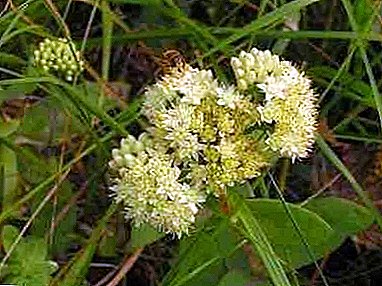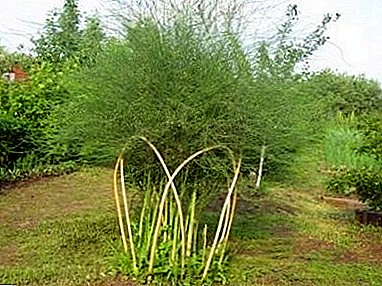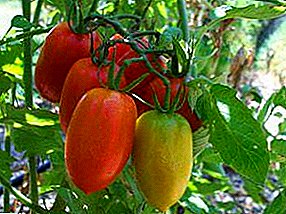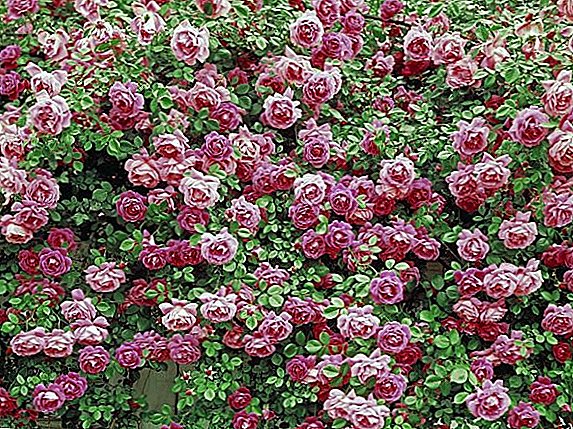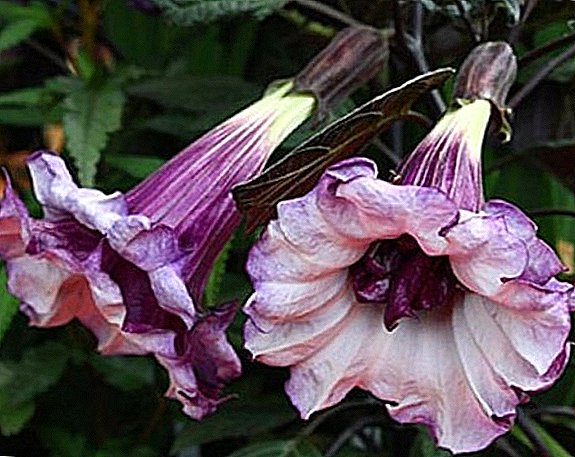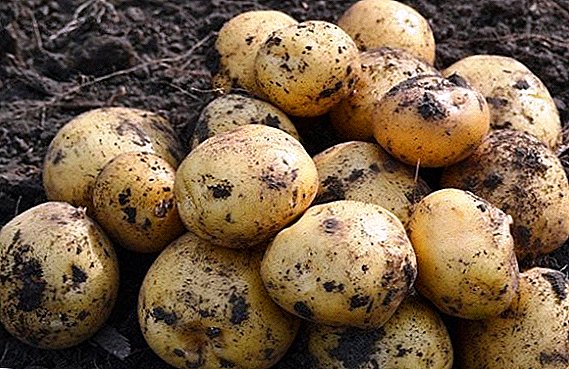 Potatoes "Lasok" was bred a quarter of a century ago. And despite the fact that during this time there were many worthy opponents, the variety managed to get the title of "classic". The reason for the continued success is the presence of a huge number of advantages, the most important of which is great taste. If you choose potatoes for your vegetable garden, then you should familiarize yourself with the variety "Lasock". And how to plant it, how to care and whether it has flaws, we will tell you further.
Potatoes "Lasok" was bred a quarter of a century ago. And despite the fact that during this time there were many worthy opponents, the variety managed to get the title of "classic". The reason for the continued success is the presence of a huge number of advantages, the most important of which is great taste. If you choose potatoes for your vegetable garden, then you should familiarize yourself with the variety "Lasock". And how to plant it, how to care and whether it has flaws, we will tell you further.
Breeding history
The variety was obtained as a result of the work of employees of the Scientific and Practical Center of the National Academy of Sciences of Belarus on Potato and Fruit-Growing. In the State Register of Plants of the Russian Federation and the Republic of Belarus was introduced in 1988. 
Botanical description
"Lasok" - famous medium late variety. The taste is considered the best.
Middle-maturing varieties are "Blue", "Zhuravinka", "Melody", "Lorch".
Tubers
The tubers of the "Lasunka" are roundish, large (150-200 g each). Peel is light yellow or pale brown, with small size, shallow eyes. The flesh is elastic, creamy. The starch concentration is 15-22%.
The main feature of the fruit - excellent dining quality. In addition to great taste, tubers have excellent crispness and boil well. This allows you to use this potato for the preparation of various side dishes, dry mashed potatoes, chips.
Important! When harvesting, small tuber crops are rarely seen.
Bushes
The plant in this variety is high (up to a meter in height), half-upright, powerful, with coarse, thick, medium-sized leaves and a thick stalk. The bush blossoms with white many-flowered inflorescences.
Characteristic variety
Data "Lasunku" characteristics allow you to appreciate this grade. 
Disease resistance
Belarusian potato variety is famous not only for its taste and unpretentiousness, but also for its immunity against such diseases:
- crayfish;
- late blight tuber;
- S.M.Y.L. virus
Medium resistance to:
- common scab;
- rhizoctoniosis (black scab);
- black leg.
Learn how to identify and combat potato diseases: late blight, scab, Alternaria.
Precocity
It is possible to start harvesting only through 90-120 (depending on the growing region) days after the shoots appear. For this period, this variety is classified as medium late. Flowering time is long.
Did you know? The third US president Thomas Jefferson once treated his friends to an unusual dish - french fries. After that, of course, the dish became popular.
Yield
Productivity is high, reaching up to 620 quintals per hectare. One bush can produce 8-12 tubers. The fruit storage capacity is satisfactory. Potatoes are temperature sensitive and germinate at + 5-7 ° C. 
Growing regions
This unpretentious variety can be successfully cultivated in most areas, including the north-western territories. So, "Lasok" is suitable for growing in such areas of the former Soviet Union:
- Central;
- Far Eastern;
- North Caucasus;
- Central Black Earth;
- Northwestern;
- Volgo-Vyatka;
- Belarus;
- Polesie;
- Transcarpathian.
It is interesting to read about the properties and uses of potatoes and potato flowers.
Landing rules
To grow on your own plot this potato can do even to a novice gardener.
Optimal timing
They start planting after the earth warms up well (not less than up to + 7 ° C at a depth of about 10 cm). As a rule, this period falls on April May (depends on climate). Since the planting of tubers is time consuming, it is better to start work early in the morning. 
Location selection
To collect a good harvest, it is important to choose the right soil. So, “Lasunku” can approach any soil - in this it is completely unpretentious. The only thing you need to pay attention to is that on the loam the tubers are deepened by 5-7 cm, and on the sandstone - by 10-12 cm. Plant the tubers better on a well-lit, level (no more than 3 ° slope allowed) place.
It is also worth remembering the crop rotation rules. It is recommended to alternate the planting of potatoes and cress, which are planted in the autumn, immediately after the harvest of tubers. It rapidly grows and develops, and after it is plowed along with it, the earth will serve as an excellent feeding.
Important! It is impossible to plant potatoes in one place for a long time, because it depletes the soil. Rest on earth should be given about once every 4 years.
The best predecessors This variety are winter crops and legumes.
Soil preparation
To soil "Lasok" is undemanding. However, the surface must be flat, without pits. In heavy ground, it is recommended to land in the ridge mode.  In the autumn, the plot intended for planting potatoes is plowed and fertilized. Manure is ideal for these purposes - it allows the plant to achieve maximum development, which increases productivity. Of course, just before planting, the soil is also prepared: cleaned of weeds, loosened, moistened.
In the autumn, the plot intended for planting potatoes is plowed and fertilized. Manure is ideal for these purposes - it allows the plant to achieve maximum development, which increases productivity. Of course, just before planting, the soil is also prepared: cleaned of weeds, loosened, moistened.
Manure of cows, pigs, sheep, rabbits, horses can be applied to top dressings in gardening.
Preparation of planting material
To harvest a good crop, it is important to prepare the tubers for planting. To do this, 3-4 weeks before planting, potatoes are taken out of storage and germinated. In order to activate the vital forces after the cold, it will take several days. Then another 2-3 weeks will sprout sprouts. Immediately before planting, the tubers can be divided into small segments.
Important! Each part should have a sprouted eye.
In order to obtain seedlings, you can use one of following ways:
- Dry. Potatoes are contained in the light in a box. Solanin forms in fruits (the peel turns green). These tubers are not suitable for food, and for planting - just right. In the future, they will be less exposed to diseases and attacks of pests.
- Wet. Potatoes are stored in raw sawdust or humus at a temperature of up to +15 ° C. In this case, not only seedlings will appear, but also small roots. After planting such material engraftment is faster and the plant grows better.


Scheme and depth of landing
The tubers are planted according to the scheme 70x40 cm. The depth of the holes should be 8-10 cm on sandy soils and 5-7 cm on loam. Beforehand, a glass of wood ash or 0.5 l of humus is poured into each hole.
How to care
Given that Lasok does not require special care, it is enough to carry out only a few mandatory procedures.
Did you know? The French agronomist Parmantier popularized potatoes in his home country: during the day, the field was carefully guarded, no outsider could take it, and at night the guards were cleaning what the local people used to want to know what kind of product was being guarded.
Watering
At first, after planting the tubers, they do not need moisture - at this time the formation of the root system occurs. Then the plant requires moderate, but infrequent, watering.
For all the time of cultivation there should be about three main irrigations. As a rule, plantings irrigate during flowering and dry days (if they last long). The process of watering is carried out in the morning. 
Top dressing
By and large, "Lasok" effectively uses natural fertility and gives good yields. However, in order to avoid excessive growth of greenery, nitrogen fertilizers should be applied to the soil (10-15% less than the dose recommended by the manufacturer). If you do not take into account this rule, the potato will give all the power to build green mass, and the fruits will be small.
During the growing season, the plant is fed with organic fertilizers with a high concentration of potassium and phosphorus (potassium monophosphate, "Diammofosk", "Nitrophos", etc.). Urea or mullein can also be used.
Important! Abuse fertilizers should not be. 2-3 fertilizing with mineral complexes is enough.
Weeding and loosening the soil
"Lasok" loves the blazing ground. The access of fresh air to the root system is important for obtaining a good harvest, so the first time they loosen the ground within 7-10 days after planting. At the same time, the first weeds are removed. The process of loosening is repeated more than once, until the time comes to spud.
Hilling
For the first time spuds bushes when they grow up to 10 cm. For this, the soil from row-spacings is raked to the trunk, sprinkling the plant from all sides. After 2-3 weeks, the procedure is repeated. On light soils, the depth of hilling should be 13–15 cm, and on heavy soils — 10–12 cm. 
Preventive treatment
To prevent the appearance of the wireworm, which can spoil the harvest fairly, a week before planting on the site, traps are set, which can be plastic cups or bottles. The containers are filled with potato peelings and buried in the ground. In 2-3 days the larvae will crawl there. If necessary, the procedure is repeated.
The wireworm is a larva of a click beetle. Wireworms act underground, affecting potato tubers.
Harvesting and storage
Harvest begins in August and ends in September. In this case, you can either use mechanical devices or manually remove them. Potatoes are dried in the open air for several hours before being stored. After that, the tubers are sorted, discarding the damaged ones, and good specimens are sent to a cool place (cellar, basement).
Important! Potatoes should be stored in wooden containers at a temperature of + 1 ... +2 ° C, adhering to a humidity of 70-80%. Under these conditions, the crop can be saved until spring.
Advantages and disadvantages
Main benefits "Lasunk" are:
- excellent yield;
- immunity to fungal and viral diseases;
- resistance to the Colorado potato beetle;
- great taste.
 Among cons Experts mark such:
Among cons Experts mark such:
- short storage period;
- abnormal heat and insufficient watering affect yield;
- soft fiber (for lovers of crisp crust is a significant disadvantage).
In the end, I want to say that "Lasok" for many years remains popular among gardeners. And, as we can see, this is deserved - it is simple to grow, does not require additional fertilizers, and is excellent against various misfortunes. Be sure to try this variety, and it will become one of your favorites.


